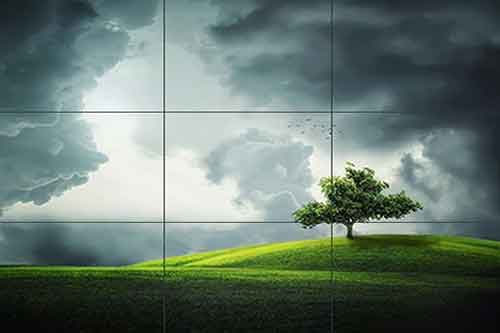| Back to Back Issues Page |
 |
|
Painting Art Ezine: A Shortcut for Composition May 20, 2022 |
, welcome to the Ezine! Here's a Shortcut for CompositionThe rule of thirds is an easy shortcut for composition. It is a tried and true method used by both photographers and artists. It makes composition super easy for the beginning artist. It gives the budding artist breathing room. They can concentrate on mixing colors and other skills without being so concerned about composition. It's Easy to Use The Rule of Thirds!The rule of thirds is often used to compose pleasing paintings. Place lines horizontally and vertically at one third and two thirds. This divides the painting surface into nine equal parts. The main subject of the painting is placed at or near one of the intersections of the lines (See the tree below.) Horizon lines of land or water are placed at or near one of the third lines. That gives us the 2:1 ratio of land to sky and land to water. Vertical subjects such as a tall waterfall or a tall building could be placed near one of the vertical divisions. A secondary focal point may be placed at another intersection of the lines. In the photo below you see the bright light near the bottom left intersection. This is a photo, so it's not so easy to move things around. But as an artist, we can move things around. A more dynamic painting would be created by having the secondary focal point at a diagonal intersection, instead of the one directly across.
Why Do We Use The Rule of Thirds?Symmetry is boring. Nothing in nature is ever in perfect balance. Even one side of our face is not an exact mirror image of the other side of our face. Only man makes things in balance in our buildings, formal landscapes, etc. They have their place and can be attractive, but not so much in paintings. There are times we may place the focal point directly in the middle of the painting. One example would be in a portrait. Do not have the subject looking directly at the viewer. It is best to place them in a three quarters view. There is a disadvantage of placing the subject in the center. The viewer's eye is drawn to the subject, then they don't look around the rest of the painting. In a landscape painting, if the horizon is placed in the middle of the painting, it cuts the painting right in half. The viewer feels discontentment and moves on to look at other paintings. The Rule of Thirds Creates Dynamic PaintingsPlacing our subject near one of the third lines or intersections, creates attractive paintings. Things are not equal, but they are still in balance. Think of a teeter tooter. The heavy person sits on the short end of the teeter tooter. Just like the subject of the painting is only one third of the way into the painting. The lighter person sits way out on a longer side of the teeter tooter to balance the heavy person. The other parts of our painting take up two thirds of the space, so they are in proportion to the heavier side. A painting with unequal parts is interesting and it attracts the viewers. The focal point draws people in. Then their eye moves around looking at the other parts of the painting. We paint for the viewers and the rule of thirds makes it easy. Do we always follow this rule? Of course not! But it is an excellent tool for the artist's tool belt. More tips for composing your paintings Enjoy!Next month, "How to Survive Painter's Block" |
| Back to Back Issues Page |
